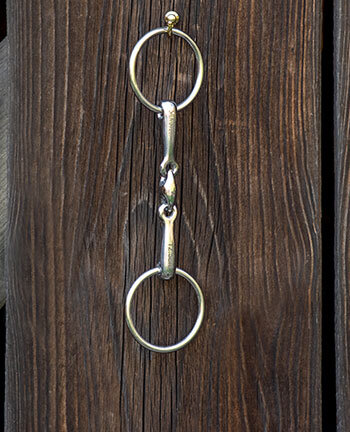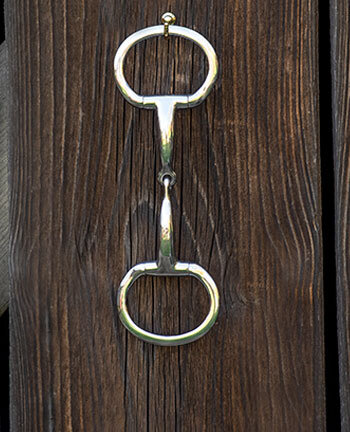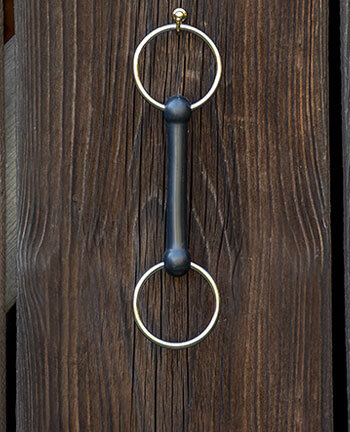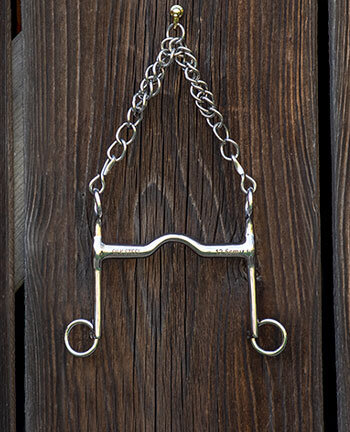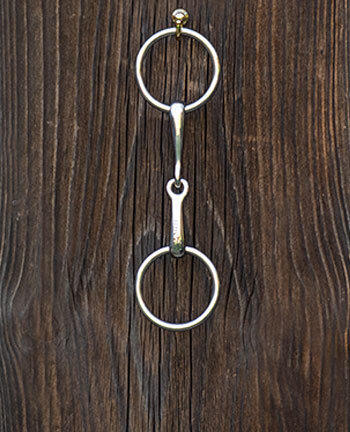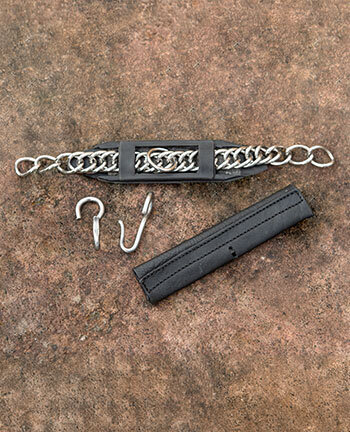
- Frequently asked questions
- What kinds of bits are there and how do they work?
- What size bit does my horse need?
- What material should a bit be made of?
- What should I pay attention to when fitting the bit?
- How should the bit lie in the horse's mouth?
- Which bits are permitted for showing/competing?
- Which bit is suitable for horses with contact problems?
Horse Bits
- Frequently asked questions
- What kinds of bits are there and how do they work?
- What size bit does my horse need?
- What material should a bit be made of?
- What should I pay attention to when fitting the bit?
- How should the bit lie in the horse's mouth?
- Which bits are permitted for showing/competing?
- Which bit is suitable for horses with contact problems?
What kinds of bits are there and how do they work?
- Double-jointed bits
- Single-jointed bits
- Eggbutt mullen mouth bits
- D-Ring snaffle bits
- Mullen mouth bit
- Weymouth bits and pelham bits
- Pony bits
In a double-jointed bit, the two parts of the bit are connected with a small middle piece, so that the bit lies flat on the tongue and mouth. However, when the bit is pulled on one side, it does not rise up in the middle so that the horse cannot push it up to counteract the pressure.
An eggbutt bit can also be single or double-jointed. However, the rings are rigidly connected to the bit parts so that the bit moves less in the mouth. This means that the aid is given more directly than with continuous bit rings. An eggbutt mullen mouth bit is therefore not suitable for riders with unsteady hands.
A mullen mouth bit exerts even pressure on the entire tongue and the jaws. However, when pulled on one side, it tilts, it is not adaptable, which is why the bit on the opposite side can pinch the tongue and mouth. This means that a mullen mouth bit is not particularly well suited for two-handed riding. A mullen mouth bit is more suitable for a well trained horse that can already be ridden one-handed and with fine aids.
A variation of mullen mouth bits are weymouth bits, which have a different effect due to the different lengths of the shanks. In general, however, the longer the shanks, the later, but the harder the effect of the bit on the head. Conversely, a weymouth bit with short shanks exerts less pressure on the head but does so more quickly. A weymouth bit may only be used with a curb chain. This directs the pressure from the bit and lower jaw to the neckpiece. Even with a weymouth bit, lateral rein aids cannot be given correctly, which is why the horse should be steered using leg and weight aids.
A pelham is a combination of a snaffle bit and a weymouth bit and is ridden with four reins, unlike a weymouth bit, but is only used with one bit without an bradoon. When buckled with a pelham roundings, it can also be ridden with only one rein. You can buy these from our bit accessories.
Pelhams are available as mullen mouth, double or single-jointed bits. All in all, the reins of a pelham are very imprecise, but very sharp on the horse. Pelhams are therefore almost only suitable for slowing down strong horses and therefore only belong in the hands of experienced, sensitive riders.
What size bit does my horse need?
Both the length and the thickness of the bit play an important role in determining the correct bit size for your horse. The bit should be about half a centimetre longer than the horse's mouth width measured from bit ring to bit ring. The length is easy to determine: Take a large bit and put it in the horse's mouth. Then pull on one side of the bit so that the bit ring touches the corner of the mouth on the other side. Now you can hold the bit with your thumb and forefinger and mark where it comes out of the mouth. This is the width of the mouth, which you can use to determine the length of the bit. Alternatively, you can use a rope.
For the correct thickness of the bit, it depends on the right feeling. Horses have different sized or small mouths, fleshy mouths or narrow and pointed mouths. The thickness of the tongue also determines the space in the mouth. Gelding and stallion owners should also pay attention to canine teeth. To say that you want a soft bit and therefore can only use a thick bit is not correct. The factors mentioned above determine how much space there is in the mouth.
You can put two fingers in the closed mouth to find out the space between the jaws. If your fingers have enough space, a thick bit with 18 to 22 mm thickness is no problem. If there is only room for one finger, you should go for a thinner bit with 14 to 16 mm. Thinner bits with 10 mm are suitable for ponies.
The size of the weymouth bit is determined by the size of the bradoon. The weymouth bit has the same shape and length as a snaffle bit but should be thin (10 mm). The weymouth bit should be chosen one centimetre shorter than the bradoon bit.
What material should a bit be made of?
The most common material for bits is stainless steel, which is composed of different metals and mixed with alloys. With alloys, you should be careful that they do not contain substances that may cause allergic reactions in your horse. The most common alloys for stainless steel bits are steel, chrome and nickel. Especially nickel should be considered critically. If your horse is allergic to nickel, you can use nickel-free bits from GOLD MEDAL with a special alloy, which we have in our range.
In addition to stainless steel, there are also copper bits or bits with copper inlays, which are often used in Western riding. On the one hand copper is antibacterial and on the other hand it can taste sweet. This causes the horse to salivate and chew more, which has a positive effect on the horse's suppleness.
An alternative to metal bits are bits made of plastic. Depending on the composition of the material, these are softer than stainless steel bits. On the other hand, they can be flavoured. At Kramer Equestrian you will find apple flavoured bits from APPLE MOUTH. The apple flavour leads to an improved acceptance of the bit and encourages the horse to chew more.
What should I pay attention to when fitting the bit?
A bit can only be effective if it is correctly positioned. This means that the bridle must be fitted in such a way that the bit is neither too high nor too low. When you pull the bridle over the ears, you can see if it is too tightly buckled and the bit is pulled up. If the bridle is pulled too tightly, the bit will quickly press on the first cheek tooth. If the cheek piece is too loose, the bit will hang too low in the horse's mouth. Use the mouth angle as a guide: If the bit is fitted correctly, there will only be a crease in the mouth angle without pulling on the rein. In the case of eggbutt mullen mouth bits, the side parts must lie directly against the horse.
If you use a drop noseband, where the noseband runs in front of the bit, the bit must not press into the corners of the mouth.
With a weymouth bit and pelham bit it is important that the curb chain rests at an angle of 45 degrees between the shank and the mouth gap when the reins are shortened. This redirects the pressure from the bit to the neck. If you have chosen the right size, there should be no gap between the lip and the side piece, but it should fit directly.
How should the bit lie in the horse's mouth?
A correctly selected bit size allows the bit to lie optimally in the horse's mouth. If the bit does not fit in terms of length and width, it will not lie centrally on the tongue, which will ultimately result in incorrect aids, but will also have an effect on the horse's entire movement. The bit lies correctly in the horse's mouth when the middle part of the bit lies centrally in the horse's mouth. There should only be one fold in the corner of the mouth without pulling the reins.
Which bits are permitted for showing/competing?
There are many possibilities to participate in competitions or shows. There are also unaffiliated and affiliated shows/competitions. Which bits are allowed depends on the respective governing body and discipline and is also updated from time to time. Before taking part in a competition or show, you should get hold of the respective current rulebook and have a thorough look at it.
Which bit is suitable for horses with contact problems?
Contact is always a matter of the appropriate bit. The bit must fit the horse perfectly so that it does not have problems with the bit. However, if the horse has problems finding the right contact, it can be helpful to change the bit. The better the bit fits the horse, the better they will accept the bit and find the contact. Make sure that the bit fits correctly so that the horse does not notice it in the mouth at all. If it were to press somewhere, the horse would resist even with correct aids. It is best to try out which type of bit is best for your horse. Because every horse is different and, besides its anatomy, also has its own sensations and preferences.



